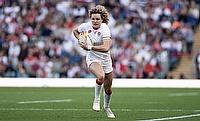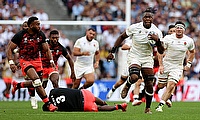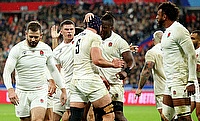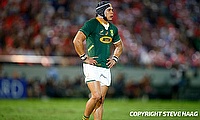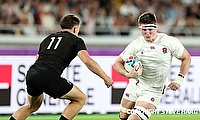Eddie Jones and England
The Rugby Football Union made official on Friday morning what the whole rugby world already knew, confirming former Australia and Japan head coach Eddie Jones as the man to lead them through to the 2019 Rugby World Cup.
Jones led his native Australia when they lost to England in the 2003 RWC final and was an assistant coach for South Africa during their victorious 2007 campaign, but is now better known for the remarkable job he did turning the Cherry Blossoms into a competitive side at this year’s tournament.
Jones’ Japan side took the scalps of South Africa and Samoa and were it not for a short turnaround prior to their loss to Scotland, may have made it to the quarter-finals. As it was, they became the first side in RWC history to win three pool games and not make it to the knockout rounds.
His players were praised for their ambition and spirit throughout the tournament and were the poster boys of a fantastic campaign for the Tier 2 sides.
While ambition and spirit are obviously things England fans will want to see their side playing with over the next four years, what exactly are the tactical and philosophical approaches Jones will bring to the role?
Among the first statements of Jones’ reign was that he hopes “to build a new team that will reflect the level of talent that exists within the English game.” This will be music to the ears of the plethora of talented youngsters currently plying their trade in the Aviva Premiership, many of whom have graduated with honours from England’s age-grade teams, with Jones citing on multiple occasions England’s two recent Junior World Championship triumphs.
The likes of Henry Slade and Luke Cowan-Dickie have already been given their first tastes of international rugby, but could soon be joined by Maro Itoje, Jack Clifford, Elliot Daly and a host of other talented players in their early 20’s. Jones has excelled at talent identification in his previous roles and if he can continue that with England, he will have taken them a colossal step forward, such is the potential of the players he has at his disposal.
One of the most noticeable trademarks Jones has is that he likes to play with two distributing playmakers in his back lines. With Japan at the RWC, Jones tended for a 10-12 combination incorporating two natural fly-halves, Kosei Ono and Harumichi Tatekawa, and there was a similar balance to his Australian sides, where he often used Stephen Larkham and Elton Flatley in conjunction with one another.
This suggests he will look to use two of Slade, George Ford, Owen Farrell and possibly Danny Cipriani come the 2016 Six Nations. Both Ford and Cipriani are limited to the fly-half position, but Farrell and Slade have experience at 12 and 13 respectively, making them versatile options for Jones’ potentially new-look back line.
Speaking to RFUTV, Jones stated his desire for England to be able to move the ball when required, which having two playmakers would certainly encourage, but to also be pragmatic and adhere to the strengths of English rugby. The strength which Jones has repeatedly mentioned has been the set-piece.
At the RWC, Japan were praised for their set-piece innovation, as they outsmarted and outperformed packs much bigger than their own. Quick strikes of the ball and the number eight moving over a spot closer to the feed allowed Japan to generate very efficient ball on their own scrum. This led to an assumption that Japan were only using the scrum as a means to restart play, but against Samoa and the USA, the Blossoms’ pack was a coherent, driving force and put their opposition under extreme pressure, even eking out a penalty try against Samoa.
Ensuring that he has the playing and coaching personnel required to implement these adaptable approaches will be key for Jones over the next few months. This could see the duo of Joe Marler and Tom Youngs make way for fresh faces in the first XV.
The hiring of Jones also likely means the end of Chris Robshaw’s captaincy. The Australian was vocal with his criticism of Robshaw during the RWC, describing the flanker as not a seven and suggesting he doesn’t have the “point of difference” at international level. Robshaw will likely remain in selection contention, but seemingly only as a blindside flanker and it’s unlikely his name will be one of the first on the team-sheet, therefore making him an unlikely candidate for the captaincy.
The Australian also has a penchant for Rugby League players and though the Sam Burgess debacle has put that a little out-of-vogue for England fans, it is an area where England have had success, albeit limited, in the past. Jason Robinson has been the most impressive convert, while Chris Ashton, Stephen Myler and Kyle Eastmond have all shone at varying levels in recent years.
Eastmond may not be a natural fly-half, but Jones could see enough of the distributor in him to make him the second playmaker in his back line. The Australian could also offer Ashton a route back into international rugby, while Super League clubs will hope not to see Jones eyeing any of their players covetously over the next couple of years.
Putting these pieces of the jigsaw together, below is a potential XV that could take to the field against Scotland in February, in what will be Jones’ first game in charge of the red rose:
1. Mako Vunipola
2. Luke Cowan-Dickie
3. Dan Cole
4. Maro Itoje
5. Courtney Lawes
6. Tom Wood
7. Will Fraser
8. Billy Vunipola
9. Ben Youngs
10. Owen Farrell
11. Jonny May
12. Henry Slade
13. Jonathan Joseph
14. Anthony Watson
15. Mike Brown

